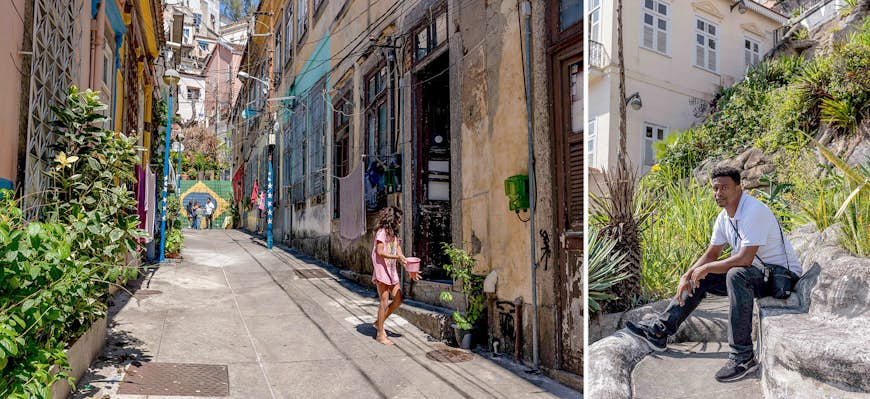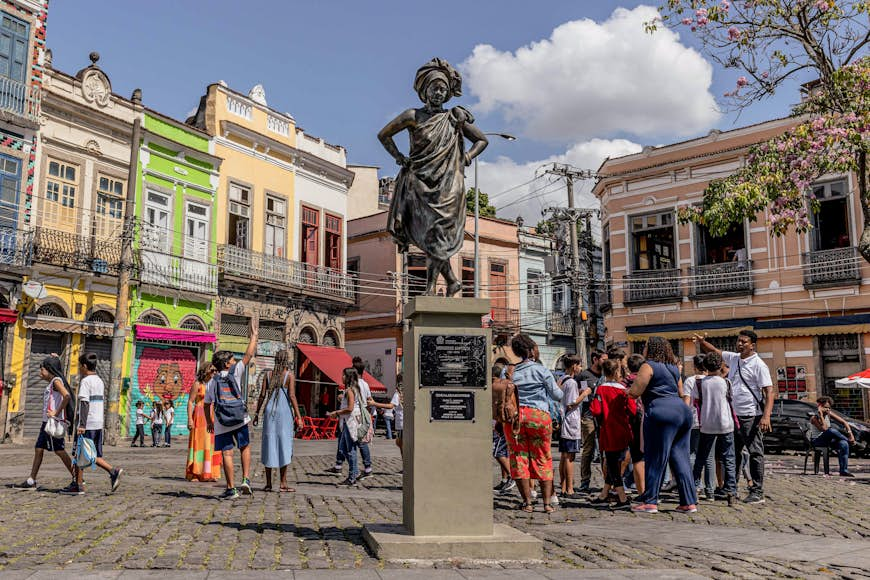Writer Georgina Lawton has been to Rio before. But on a recent trip, she travels through the city with a clear mission to venture off the tourist trail and uncover the city’s African heritage.
A blue sky – naked except for the burning midday sun – radiated a heat so heavy that I was almost wilting as I strolled through a market in Rio de Janeiro. As I pulled my hair up and off my neck, I ambled past street stalls loaded with neon bikinis and bottles of molho de pimenta, a fiery hot sauce. I ducked beneath long, green sugarcane stalks balanced precariously on the shoulders of shirtless men and weaved around children selling sweets and cigarettes beneath bright umbrellas.
The Rio neighborhood of Madureira is 70% Black and situated 40 minutes from Copacabana in the city’s North Zone. It rarely tops any “must-see” tourist lists, but I came to the city on a mission to uncover Rio’s African roots, so I made like the Cariocas (people from Rio de Janeiro) and acted unbothered by the sweltering temperatures.
It was my second time in Rio and at Carnival. The first time, in 2019, Cariocas took me to street parties and helped me source rides home. I remember marveling at their openness. I remember the joy I felt from seeing brown bodies of every shape, shade and size jiggling in the sun, slicked with glitter. This time, I wanted to dig beyond the in-your-face hedonism of Carnival. I already knew that Brazil’s greatest cultural export, Carnival, had primarily been built on the backs of Black Brazilians. But even then, to many who visit Rio, the influence of a vibrant and adaptive African diaspora isn’t immediately visible. Images of lithe and light Carnival queens persist, and popular bars are often socially segregated by class and race. On this visit, I wanted to find out about Brazil’s African history beyond the mainstream tourist circuit.
Neighborhoods, worlds apart
In Madureira, I met Rayanne Moreira, a friend of a friend. “You blend in so well I wasn’t sure if it was you,” Rayanne said laughing when she arrived. I would hear this a lot. As a Black woman, in Madureira I could trick people into thinking I was a local – as long as I didn’t open my mouth.

Moreira led me on a tour of Mercadão de Madureira, a shopping mall. There were stores selling homeware, clothes and electronics. This was a place where you could buy anything except the souvenir keyrings, trinkets and fridge magnets I’d seen back in central Rio. I picked up a diamante belt and 500 grams of braiding hair, astonished at the bargain prices. Over a snack of chicken pastries and sugarcane juice, Moreira, who has grown up in Madureira, explained that her neighborhood is actually home to some of the most famous samba schools in Rio, and that Carnival, although officially canceled in February, would still involve plenty of informal celebrations.
Moreira, who was similar to me in curl pattern and complexion except for a smattering of freckles across her face and blonde hair, was dressed in all white. She explained this was for a “purification period” dictated by her religion. Originating from the Yoruba people in Nigeria, Ifá is one of Brazil’s African religions, with Candomblé and Umbanda being more commonly practiced.

“They’ve been stigmatized for centuries,” Moreira told me. “Things are getting better slowly.” Brazil, although officially secular, has been deeply influenced by Catholic teachings for generations. In 1890 The Penal Code outlawed the practice of Afro-Brazilian religions, equating them with black magic and denigrating them as backward. Enslaved people fused their own deities, known as orixás, with Roman Catholic saints to enable secret worship while staying true to their own beliefs. These religions are often described as a “fusion” of Catholic traditions with West African spirituality, but such terms obscure their painful roots. The fusing was necessary for survival, to preserve hope. As I’ve learned in my travels, such adaptive methods transcend geography, underpinning much of the African diaspora.
Over half of the 10 million Africans enslaved in the New World ended up in Brazil, forced to toil in sugar plantations under a brutal Portuguese empire. African influence has soaked into Brazil, like water into soil. But you’d be forgiven for missing that when sipping cocktails in Rio’s downtown bars in Leblon and Copacabana, many of which are segregated by race, class and skin shade.

One night I was one of the only Black people at a bar in Leblon, a neighborhood in Rio’s South Zone that fizzes with youth and affluence and is bordered by its more famous neighbor, Ipanema. The same thing happened when I took myself out for a solo dinner in Copacabana. I felt eyes boring into the back of my head as I sipped red wine and twirled pasta around my fork.
I was also shocked at how poverty and homelessness had visibly worsened since my first visit in 2019. “It’s Bolsonaro,” my friend Alice Santos said, referring to the right-wing president who once said he’d rather have a dead son than a gay one and who also denied the existence of racism in Brazil.
A university lecturer who I met in 2019, Santos lives in Niteroi, 30 minutes from the center of Rio. She was robbed on a bus at gunpoint the week she was due to meet me. Shaken but unharmed, she blamed Bolsorano’s decision to halve COVID assistance for poor Brazilians in October 2021, which caused poverty levels to shoot up to 13%. “People are poorer than ever before, and that means they are more desperate,” she said. “I am 34, and I have never been robbed in my life until this year.”

Uncovering history
The next day, I made my way to the Pequena África (Little Africa) neighborhood with tour guides Lua Ferreira and Eddie Vander. After Madureira, Little Africa is the city’s second epicenter of African culture. I started the day in Mauá Square, in Centro, the north of the city. “Black tour guides with a Black journalist in a Black neighborhood in Rio? It’s not normal, but it’s special,” Ferreira said, laughing. She told me of her many years working for mainstream tourist companies and struggling with the content and her majority white co-workers before deciding to run her own, which covers Brazil’s black history.
Demand in recent years, she says, has soared, so much so that those same co-workers are now labeling themselves as experts in “afro-history.” In recent years, Little Africa had been lauded by international media as a great place to visit, with interest in Rio’s African roots rapidly increasing just as a new civil rights movement gains momentum across the country. Ever at the forefront of that change, Ferreira had appeared on television and given special tours to Brazilian celebrities.

We strolled through the square, a flat concrete space peppered with palm trees and facing the aquamarine waters of Guanabara Bay. Dilapidated until 2016, when it was revamped for the Olympic Games, it now boasts the Museum of Tomorrow on a long pier and the Museum of Art close by. As we walked, she greeted families in the street and made small talk with construction workers.
Eventually, we reached Francisco da Prainha square, a small plaza surrounded by colorful bars that was mostly deserted at midday. In the center of the square, an 8ft statue depicts Mercedes Batista, the first black female dancer to dance in Rio’s Municipal Theater.

“It was only added in 2016 when the government cleaned up this area,” Ferreira noted as two little girls ran past us in pink tutus. “Brazil has ignored Black people for so long. But finally, girls like this can see themselves in this city,” she continued, while gesturing toward the statue. Nearby is Pedro do Sal, a rock upon which Africans in bondage were forced to break huge chunks of salt. It became the site of Rio’s first community for free and escaped slaves, known as a quilombo, and today is a popular spot for locals and tourists seeking open-air samba parties.
While contemplating all the tragedy that had befallen this city over the centuries, I watched a man wash a fluffy dog as children played ball games around us. From a window somewhere, I heard a hypnotic drumbeat. According to Ferreira, Pedra do Sal is the birthplace of samba. When I asked whether that distinction really belongs to Salvador in the state of Bahia as I had heard elsewhere, she got very serious. “It came from Pedra do Sal,” she said, looking directly at me. “People must respect history.”

When we reached another nearby square, I was shocked to learn it was Valongo Wharf, one of the world’s largest slave ports and the entry point for millions of enslaved Africans in Brazil. It was hidden from sight by the Portuguese and buried away after slavery was abolished. But when the infamous structure was accidentally rediscovered in 2011, it sparked a debate about how to memorialize slavery. It’s a debate that hasn’t been settled, Ferreira noted, pointing out the very small plaque in English and Portuguese that describes the wharf’s history in just a few lines. “We have a long way to go,” she said.
For dinner, we gathered at Yayá Comidaria in Leme, central Rio, where founder and chef Andressa Cabral is known to talk passionately about cooking West African-influenced cuisine.

“We are preserving tradition but also rewriting stories,” she said, presenting the table with a mixed fish and pepper stew served in a sizzling terracotta pot. The dish, I learned, was originally prepared with coconut milk by the Portuguese in Salvador before being remixed by Africans in Brazil who added dendê (palm oil) and chili. Cabral’s take on moqueca blends both. The scent of fish, spices and onions wafted around the table as she served stew on plates piled high with salad and farofa (fried flour).
“Every 23 minutes in this country, a Black boy is murdered in Brazil,” she said plainly as she served us, standing over the hot pot. “It is not possible for Black people to think about their futures in Brazil. I decided to control mine through food.”

The idea of expanding the possibilities for Black life by designing a different future fills me with hope. It’s a feeling that washes over me once more when I return to Pedra do Sal with Vander later that night and bear witness to a Brazilian street party, or “bloco,” one of many that popped up during the unofficial carnival. Sandwiched among a sea of bodies shiny with sweat in the humid night air and sipping a caipirinha from a plastic cup, I swayed to samba played by live singers and joined in when crowds began emphatically chanting anti-Bolsonaro slogans. Chatting with Eddie’s friends, who at first mistook me for a Carioca woman, the conversation unfolded effortlessly. Despite being thousands of miles away from my own family and friends, it felt a whole lot like home.
